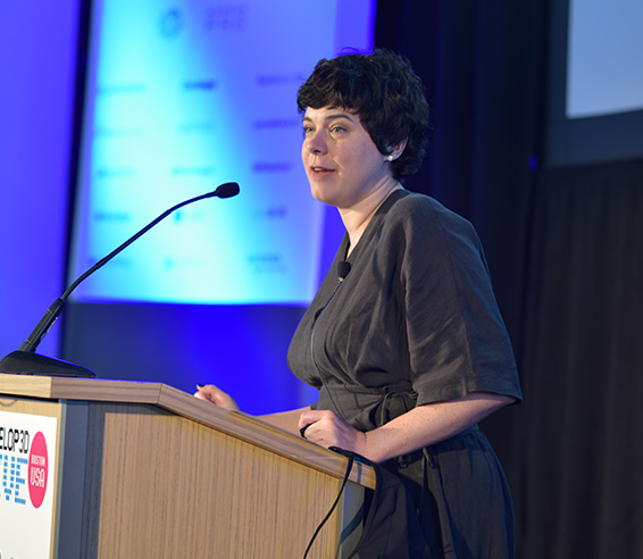In this month’s comment Sarah Krasley contemplates the importance of elasticity to not only her new swimsuit designs but to the setting up and running of a successful business

Sarah speaking at the inaugural DEVELOP3D Live in Boston last month
It’s a warm Friday afternoon in late September and my inbox is full of identical, automatically generated chipper emails from friends and colleagues.
With just one click of a “Like”, LinkedIn has helped them wish me well on reaching the first anniversary of my little company where I am attempting to build systems to help accelerate the path to mass customised apparel, beginning with a category that desperately needs attention: women’s swimwear.
Amidst the work bootstrapping the bathing suit company, I take on some consulting and writing projects. I’ve just gotten off the phone with Martyn Day.
We ran through the topics that will be presented at DEVELOP3D Live (click here for the show report) on 26 September at District Hall in Boston where I will serve as Master? Mistress? Matron? (I hope not) of Ceremonies.
As we talked, I played with a piece of swimsuit elastic that was sticking out of my sample bag and jotted down notes about the speakers’ companies—IoT (Internet of Things) enabled farms in storage containers, tidal turbines, 3D printed structures, wearable tech for construction sites, BOSE’s product design and innovation processes, an aqueous robot to protect us from active shooters and terrorists.
I very literally focused on elasticity in my swimsuits and data models this year.
Elasticity in stretchable fabrics can fluctuate from downright structural (and highly uncomfortable) to bouncy and soft. Each has some give to deal with shapes that are nuanced. I learned about elasticity quotients of fabrics that best work on the aforementioned, ahem, nuances, and how to account for them in pattern making.
I thought about my own elasticity as an entrepreneur — how much could I stretch to get everything done? Where was my skillset brittle? Where was it robust? Elasticity was also a theme that ran consistent in my choices as I set up my business: how can I make this company flexible, yet strong with limited resources? How can I make the most resilient business possible so we can pivot easily and meet our milestones?
Resilience, for better or worse, is also a theme that is hard not to notice and appreciate in the world. Unbelievable things happened this year and life had to go on.
Then more unbelievable things happened. I’ve asked the oldest people I know if the world has ever seemed this volatile to them, and unanimously and quickly, they say “no”.
While it’s easy to recognise resilience as a personality characteristic in our friends, family, and people we admire; it’s harder to pinpoint and appreciate it within the systems on which we rely. And, while we are but mere mortal product designers, entrepreneurs, technologists, and engineers, we must elevate resilience as a major design requirement not only to deal with the world in which we live but because we will go out of business if we don’t.
In the built world, we are beginning to see this in plans for a new park that hugs the coast of lower Manhattan and incorporates floodplains into the design so water can wash in and out in a way that diffuses its power and protects buildings a block or two inland. New buildings at sea level feature snap in electrical lines that can be easily refurbished if ground floor levels become submerged by flood waters.
In product design, we have long battled the want for resilience and strength with concerns of over-engineering. How many back-up plans are needed? How do we balance want for resilience with cost, timeto-market, and elegant simplicity?
The instrumented world will help with this, undoubtedly. Sensors inside products and within infrastructure will work with analytics services to track, assess, and adapt without human intervention and at much faster rates than we can worry about half-baked back-up plans.
Sarah Krasley is the founder and principal of product, service and workplace policy design firm, Unreasonable Women. She recently founded X Swimwear and is also an Adjunct Professor at New York University’s ITP Program. Learn more about her at sarahkrasley.com
Sarah Krasley on the importance of elasticity in establishing a successful business
Default






